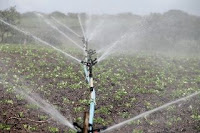यदि प्रयाप्त सिचाई सुविधा उपलब्ध है तो कपास की फसल को मई माह में ही लगाया जाता है। सिचाई की प्रयाप्त उपलब्धि न होने पर मानसून की उपयुक्त वर्षा होते ही कपास की फसल लगा सकते है। कपास की उतम फसल के लिए आदर्श जलवायु का होना जरूरी है। फसल को उगाने के लिए मोसम का तापमान सामान्य रूप से 16 डीग्री और अकुरन के लिए आदर्श तापमान 32 से 34 डिग्री सेल्सियस उचित है। कपास के लिए आदर्श बारिश 50 सेंटिमिटर होना आवश्यक है और 125 सेंटिमिटर से ज्यादा बारिश होना हानिकारक है।
कपास की खेती के लिए भुमि का चुनाव
कपास के लिए अच्छी जलघारन ओर ओर जल निकास क्षमता वाली भूमि होनी चाहिए। जिन क्षेत्रों में बारीश कम होती है वहां इसकी खेती अघिक जलघारन क्षमता वाली मटियार भूमि में की जाती है।
कपास की खेती के लिए खेत की तैयारी
उतरी भारत में कपास की खेती मुख्यत सिचाई की प्रयाप्त उपलब्धि में होती है। ईन क्षेत्रों में खेत की तैयारी के लिए ऐक सिचाई कर 1 से 2 गहरी जुताई करनी चाहिए एवं इसके बाद 3 से 4 हल्की जूताई कर पाटा लगाकर बुवाई करनी चाहिए। कपास का खेत तैयार करते समय यह याद रखे कि खेत पुरी तरह समतल हो ओर ताकि मिट्टी का जलघारन एवं जल निकास क्षमता दोनों अच्छे रहे। अगर खेतों मैं खरपतवार की समस्या न हो तो बिना जुताई से भी कपास की खेती की जा सकती है।
कपास की उन्नत किस्मे
देश में वर्तमान में बी. टी कपास अघिक प्रचलित है। जिसकी किसमो का चुनाव किसान भाइयों अपने क्षेत्र की परिस्थित के अनुसार ककर सकते हैं।






























